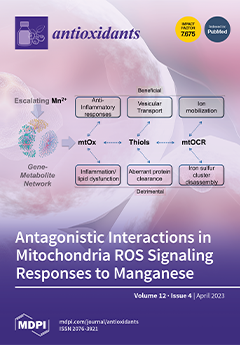This study aimed to assess the protective effect of an extract of
Lonicera japonica against particulate-matter (PM)
2.5-induced pulmonary inflammation and fibrosis. The compounds with physiological activity were identified as shanzhiside, secologanoside, loganic acid, chlorogenic acid, secologanic acid, secoxyloganin, quercetin pentoside, and
[...] Read more.
This study aimed to assess the protective effect of an extract of
Lonicera japonica against particulate-matter (PM)
2.5-induced pulmonary inflammation and fibrosis. The compounds with physiological activity were identified as shanzhiside, secologanoside, loganic acid, chlorogenic acid, secologanic acid, secoxyloganin, quercetin pentoside, and dicaffeoyl quinic acids (DCQA), including 3,4-DCQA, 3,5-DCQA, 4,5-DCQA, and 1,4-DCQA using ultra-performance liquid chromatography–quadrupole time-of-flight mass spectrometry (UPLC-Q-TOF/MS
E). The extract of
Lonicera japonica reduced cell death, reactive oxygen species (ROS) production, and inflammation in A549 cells. The extract of
Lonicera japonica decreased serum T cells, including CD4
+ T cells, CD8
+ T cells, and total T helper 2 (Th2) cells, and immunoglobulins, including immunoglobulin G (IgG) and immunoglobulin E (IgE), in PM
2.5-induced BALB/c mice. The extract of
Lonicera japonica protected the pulmonary antioxidant system by regulating superoxide dismutase (SOD) activity, reduced glutathione (GSH) contents, and malondialdehyde (MDA) levels. In addition, it ameliorated mitochondrial function by regulating the production of ROS, mitochondrial membrane potential (MMP), and ATP contents. Moreover, the extract of
Lonicera japonica exhibited a protective activity of apoptosis, fibrosis, and matrix metalloproteinases (MMPs) via TGF-β and NF-κB signaling pathways in lung tissues. This study suggests that the extract of
Lonicera japonica might be a potential material to improve PM
2.5-induced pulmonary inflammation, apoptosis, and fibrosis.
Full article






